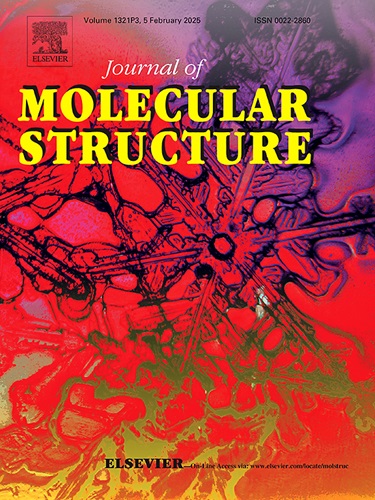通过硅学工作流程鉴定新型噻唑烷-4-酮作为潜在 PPARγ 调节剂的命中率,并通过体外研究进行验证
IF 4
2区 化学
Q2 CHEMISTRY, PHYSICAL
引用次数: 0
摘要
全PPARγ激动剂如噻唑烷二酮已显示出显著的降糖效果,但与显著的副作用相关。部分PPARγ激动剂提供卓越的疗效和最小的副作用。在大量文献综述的基础上,设计了一个新的C-2和C-5二取代噻唑烷-4- 1类似物库作为合成可行的PPARγ调节剂。一个多步骤的计算工作流程,包括分子对接、MM-GBSA计算、ADMET预测、MD模拟和DFT分析,指导了有希望的候选者的选择。在各种有前景的化合物中,化合物1 (-8.189 kcal/mol)和106 (-8.383 kcal/mol)在对接研究中表现最好,优于罗格列酮(-7.057 kcal/mol)和吡格列酮(-7.381 kcal/mol)。此外,ADMET分析证实了药物相似性,MD模拟强调了与关键残基的稳定相互作用,特别是Ser342,一个与部分PPARγ激动作用相关的关键残基,可能有助于减少副作用。这两个潜在的打击。共合成了106种PPARγ受体,对其体外活性进行了表征和评价,与吡格列酮(0.65±0.19µM)和罗格列酮(0.35±0.08µM)相比,EC50值分别为8.71±2.0µM和13.1±2.2µM。体外葡萄糖摄取试验也证实了所鉴定的hit 1和106具有与吡格列酮相当的良好降糖作用。此外,对HEK-293细胞的体外细胞毒性试验表明,IC₅0值为1和106的751.1µM和2869µM,分别表明低毒性和对增加药物浓度的高耐受性,具有良好的安全边际,可供进一步开发。本文章由计算机程序翻译,如有差异,请以英文原文为准。

Identification of novel thiazolidine-4-one based hits as potential PPARγ modulators through in silico workflow and validation through in vitro studies
Full PPARγ agonists like thiazolidinediones have shown notable antidiabetic efficacy but are associated with significant side effects. Partial PPARγ agonists offer superior efficacy with minimized side effects. Based on the extensive literature review, a novel library of C-2 and C-5 disubstituted thiazolidine-4-one analogs was designed as synthetically feasible PPARγ modulators. A multi-step computational workflow, including molecular docking, MM-GBSA calculations, ADMET predictions, MD simulations, and DFT analysis, guided the selection of promising candidates. Among the various promising designed compounds, compounds 1 (-8.189 kcal/mol) and 106 (-8.383 kcal/mol) emerged as the most potent hits, outperforming rosiglitazone (-7.057 kcal/mol) and pioglitazone (-7.381 kcal/mol) in docking studies. Further, ADMET profiling confirmed drug-likeness, and MD simulations highlighted stable interactions with key residues, notably Ser342, a crucial residue linked to the partial PPARγ agonism which may help in reducing the side effects. These two potential hits 1 & 106 were synthesized, characterized and evaluated in vitro for PPARγ agonistic activity wherein they displayed EC50 values of 8.71±2.0 µM and 13.1±2.2 µM, respectively compared to pioglitazone (0.65±0.19 µM) and rosiglitazone (0.35±0.08 µM). In vitro glucose uptake assay also confirmed good hypoglycemic action of the identified hits 1 and 106 comparable to pioglitazone. Furthermore, in vitro cytotoxicity assay against HEK-293 cells demonstrated IC₅₀ values of 751.1 µM and 2869 µM for 1 and 106, respectively suggesting low toxicity and high tolerance to increasing drug concentration with a favorable safety margin for further development.
求助全文
通过发布文献求助,成功后即可免费获取论文全文。
去求助
来源期刊

Journal of Molecular Structure
化学-物理化学
CiteScore
7.10
自引率
15.80%
发文量
2384
审稿时长
45 days
期刊介绍:
The Journal of Molecular Structure is dedicated to the publication of full-length articles and review papers, providing important new structural information on all types of chemical species including:
• Stable and unstable molecules in all types of environments (vapour, molecular beam, liquid, solution, liquid crystal, solid state, matrix-isolated, surface-absorbed etc.)
• Chemical intermediates
• Molecules in excited states
• Biological molecules
• Polymers.
The methods used may include any combination of spectroscopic and non-spectroscopic techniques, for example:
• Infrared spectroscopy (mid, far, near)
• Raman spectroscopy and non-linear Raman methods (CARS, etc.)
• Electronic absorption spectroscopy
• Optical rotatory dispersion and circular dichroism
• Fluorescence and phosphorescence techniques
• Electron spectroscopies (PES, XPS), EXAFS, etc.
• Microwave spectroscopy
• Electron diffraction
• NMR and ESR spectroscopies
• Mössbauer spectroscopy
• X-ray crystallography
• Charge Density Analyses
• Computational Studies (supplementing experimental methods)
We encourage publications combining theoretical and experimental approaches. The structural insights gained by the studies should be correlated with the properties, activity and/ or reactivity of the molecule under investigation and the relevance of this molecule and its implications should be discussed.
 求助内容:
求助内容: 应助结果提醒方式:
应助结果提醒方式:


